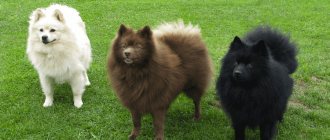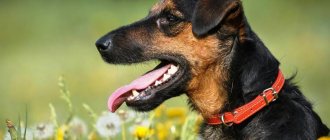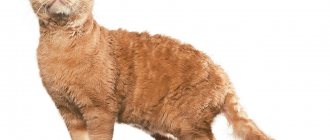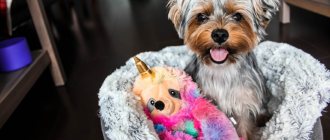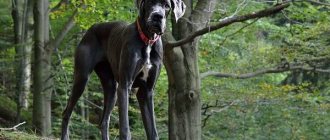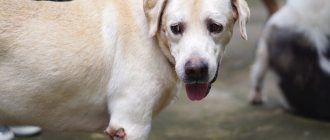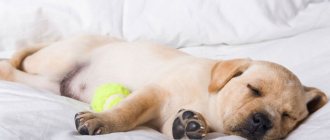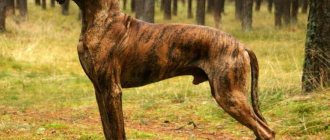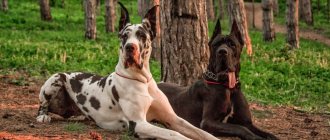Characteristics and breed standard
The height of a male starts from eighty centimeters, the female is slightly lower - from seventy-two centimeters. But you shouldn’t be afraid of them, because these giants are friendly and angelically kind. They have a harmonious physique, noble posture and expressive head.
The general characteristics of dogs of the Argentine Bulldog breed are very similar to the description of German bulldogs. Because these dogs are related. But Argentines are slightly smaller in size.
According to the standard, the weight of a Great Dane should be about ninety kilograms. The male body shape corresponds to a square, while the females have a slightly elongated body. These dogs have a rather large head, flattened on the sides and a pronounced transition from the forehead to the nose. Great Danes of all colors (with the exception of merle) have a black nose.
These dogs have very intelligent eyes. Most often they are dark. But in representatives of the merle color they can be light, and blue Great Danes sometimes have eyes of different colors. Dogs have large, high-set ears that hang freely.
A characteristic feature of Great Danes is the presence of a powerful neck with well-developed muscles. When the dog is actively moving, the neck bends slightly forward, and in the stand position it is placed vertically.
The breed standard calls for a flat back, which has a curve at the base of the tail. The tail is of medium length; during movement it rises slightly, but does not curl. The paws are smooth and have well-developed muscles.
What else can Great Danes be?
This breed has a wide range of colors. There are coat color options that are recognized by canine communities and are included in the breed standard. But there are also colors that are not included in the standard and are not developed by breeders.
Important! Animals with non-standard coat shades are discarded and do not participate in exhibitions and breeding.
Standard colors
In the standard description, there are only 5 coat colors that are characteristic of the Great Dane. They are all very impressive and help make the breed recognizable.
Among them:
- marbled (beautiful and recognizable “harlequin”, white short hair, tight to the body and black spots of different sizes, evenly distributed throughout the body and having torn edges);
- brindle (unusual but attractive color, against the background of red fur, black and gray stripes, randomly located throughout the body, look very impressive);
- blue (in normal lighting the coat looks gray, but with the glare of the sun and the right angle, a blue tint appears; both the dog’s complete coverage with blue fur and small patches of white spots on the chest and paws are allowed);
- fawn (or often called red, very similar to brindle, but does not have stripes scattered over the body);
- black (full coverage of the dog’s entire body with jet-black hair or the presence of white spots on the toes and chest of the animal is allowed).
All shades are clearly regulated and strictly taken into account by the judges at the shows. Any deviation from the standard description is considered defective.
Unusual colors
Among the unusual colors are mantle (white chest on a black background, often a white mask), platten (the same “harlequin”, but the black spots have clear boundaries and are also located strictly on the chest and rump), gray merle (similar to harlequin, but the background is not white, but gray or blue).
Such pets do not have the opportunity to participate in exhibitions and further breeding. Such pets are often obtained as a result of improper crossing or unplanned mating of dogs with different colors.
Regardless of color, the Great Dane is a very stately and beautiful dog. They proudly carry their heads, condescendingly looking at the world from the height of their enormous height.
Similar articles
History of the origin of the breed
Tibet is considered the habitat of the ancestors of the modern Great Dane breed. For ancient eastern tribes, these dogs served as shepherds. Not only Great Danes descended from them. Oriental shepherds played a significant role in the creation of other breeds, including Asian Shepherds and Tibetan Great Danes, which were directly used by breeders in the process of breeding the Great Dane breed.
Very quickly, the large-sized dog breed gained popularity not only in the central lands of Asia, but also actively migrated to neighboring countries - India, China, Mesopotamia. During archaeological excavations in these countries, images of Great Danes were discovered painted on the walls of houses and other architectural objects.
Fighting glory
The dogs of this breed also gained fame as fighters from their participation in wars. Great Danes were actively used during military campaigns by the Greeks, Romans, Scythians, as well as Germanic tribes. At that time, the largest population of Great Danes was in Germany.
Great Danes
Among all the varieties at the beginning of our era, the most popular were the Great Dane. This species became the basis for the development of the German breed, since, unlike the mastiff, the Great Dane had a drier and more graceful body structure. Danish dogs were excellent hunters and also had excellent guarding qualities.
Breed improvement
During the period of decline in the popularity of these animals in their native lands, purebred representatives began to be actively transported to Germany. These pets were highly valued among German breeders, so breeders began to actively improve the dogs.
This process was believed to involve crossing the main gene pool brought from Denmark with Great Danes living in the south of the country. As a result of such actions, the Ulm and "improved" Great Danes were created, which were later combined into the Great Dane breed.
In 1879, Great Danes were given the status of national dogs of Germany. Ten years later, the first breed club was founded. After another two years, the official description of the Great Dane breed was adopted and the standard was approved.
Today, Great Danes are popular not only in European countries, but throughout the world. They are guards, hunters, but their main purpose is to be a human companion. Thanks to its mental abilities, gentle disposition and boundless devotion, this pet is perfect even for an inexperienced owner.
Record holders in height among Great Danes
The absolute leader among all dogs and Great Danes, including a pet named Zeus. His record height for a dog of 111.8 cm at the withers is listed in the Guinness Book of Records. But there is an absolute record holder who was not included in the official documents, but surpassed the champion in size.
This giant is Giant George from Arizona. This is a dog of the Great Dane breed, whose height at the withers was 109 cm and weight was about 111 kg. With such a combination of parameters, the dog surpassed the record holder.
Features of Great Danes
The Great Dane is characterized by short hair that lies close to the body. As with other purebred dogs, the possible colors are described in the standard and in case of deviation from the norms, the dogs will not be allowed to participate in exhibitions.
The international standard allows for the colors of Great Danes:
- Marble.
- Brindle.
- Blue.
- Pale yellow.
- Black.
Marbled Great Danes are also called white or “harlequins.” This species has white fur, and black spots of different shapes and sizes are located on the body. Red dogs with black and gray stripes are considered brindle. The stripes are quite small and placed randomly.
A Great Dane puppy with a blue color . Essentially, this color is a dark shade of gray, and in certain lighting it has a blue tint. A fawn color is considered to be red (without stripes or spots). Black Great Dane puppies can be evenly colored, but white patches are allowed on the chest and toes.
Features of Great Danes with blue fur
The appearance of a blue tint of fur from a certain angle is the “highlight” of this color. Pets that are completely ordinary within their breed under certain circumstances become incredibly attractive.
Important! Blue color is included in the breed standard. Such pets have the opportunity to build a show career.
Color
The pet's coat, like that of its relatives with other shades of coat, is short and lacks undercoat. Such an animal can live exclusively at home, as it cannot tolerate high and low temperatures.
The pet's color can be completely blue or diluted with small white spots on the dog's chest and paws. Judges at competitions and shows carefully monitor the purity of the breed and the correct color.
Character
Like all Great Danes, the blue pet has incredible friendliness and is very affectionate. They selflessly adore their owner and all members of the family in which they live. These are very tactful and understanding dogs; they will not insist on active games and long walks if the owner is tired or sick.
Great Danes are almost invisible in the house. Like cats, they curl up and can sleep for hours without being active. At the same time, they are excellent guards and are wary of all strangers.
Great Dane character
These dogs are very kind, especially Great Danes are absolutely safe for children. They are patient and very careful with the little residents of the house. The dog feels the responsibility to care for and protect the child. But it is worth remembering that Great Dane puppies, whose homeland is Germany, are quite impulsive. While playing with an adult, the pet may unexpectedly jump on the owner and knock him to the ground. Therefore, be careful and train your pet from puppyhood.
Experienced dog breeders claim that only a purebred representative of the breed is guaranteed to have an exceptionally positive character. In the process of crossing a Great Dane with other breeds, changes in character may occur. Among these puppies there may be aggressive or cowardly ones.
Some researchers claim that the first representatives of the breed were distinguished by their aggressiveness and evil disposition. To prove this theory, historical facts can be cited that indicate the participation of these giants in dog fights.
How to choose a puppy?
If you decide to purchase a Great Dane puppy, it is better to contact a professional nursery or a trusted breeder. So, you are guaranteed to receive a purebred and healthy dog that has all the necessary vaccinations and documents. The cost of a purebred baby varies from 40 to 60 thousand rubles. When buying a dog second-hand, the price will be significantly lower - about 15 thousand. But remember that with such a purchase you cannot receive any guarantees.
Great Danes are not only distinguished by their significant size, they also require special conditions of maintenance, which may incur additional financial costs. The process of caring for an animal requires a lot of time. Pay attention to these nuances before you go for a puppy.
Maintenance and care
Representatives of this breed cannot be classified as long-livers. Their average lifespan is about eight years . But if the care of the pet complies with all the rules, it can live up to twelve years. What is proper dog care?
Since the Great Dane has short hair and no undercoat, it is not recommended to keep it outside. These dogs need to live indoors with plenty of space. There is no need to bathe your pet often; perform water procedures only when absolutely necessary. Remove dirt and dust with a damp cloth.
Wipe your eyes regularly with a cotton swab soaked in a decoction of medicinal chamomile. When the nails do not wear down naturally, they need to be trimmed. The standard of care involves regular cleaning of ears that are not cropped using a special product. The Great Dane needs regular and long walks in the fresh air. But active games and running will not be to his liking.
Features of Great Danes with gray fur
The palette of shades of Great Dane wool is very diverse. Gray fur can be present in animals of several colors. For example, colors such as gray marble are distinguished. Also included in the standard description of the breed, the blue shade of the coat can also be called gray. Since the unusual shade appears only from a certain angle.
Color
The color “gray marble” is not classified as a separate group. Such dogs are considered defective by breed and do not participate in exhibitions. Although such pets have gained considerable fame, and some breeders exclusively breed Great Danes with this coat color.
The pets are very similar to “harlequin” mastiffs, but in this case large black spots with jagged edges are located not on a white, but on a gray background. The coat, like that of its relatives, is short and lacks undercoat.
Important! Gray marble may have small white flecks on the animal's paws and chest.
The blue color, on the contrary, is included in the register of standard colors. In a normal situation, the animal looks light gray. The color of the coat is deep and quite unusual. At a certain angle and lighting, the wool gives a shade of blue. That is why such dogs were characterized by this unusual color.
Character
The color of a Great Dane's coat does not affect its character in any way. Today they are very affectionate and calm animals that do not show aggression just like that. They behave in society with royal dignity, looking from the height of their height at others with condescension and nobility.
In a home environment they are almost invisible. They can curl up into a ball and sleep while the owner is somewhere nearby. They love active games and walks, but will not insist if the dog owner is not in the mood or cannot afford to go for a run.
Health problems
Unfortunately, the Great Dane cannot boast of good health. This breed often suffers from bloat, which can be fatal. The cause of this problem is excessive movement after eating. Parasites can also appear in the intestines. To prevent problems, regularly carry out helminthiasis prevention.
Dogs of this breed are prone to joint diseases, especially in old age. Sometimes there is an inversion of the eyelids. Every owner should remember that after spaying a Great Dane female, there is a high probability of urinary incontinence. It will be impossible to cure such a disease.
A dog's health may depend on its color. Blue Great Danes are genetically prone to immune system diseases, and merle representatives of the breed are prone to infertility, hearing loss and vision loss.
Great Dane: features of the breed
- The Great Dane is people-oriented and can be easily trained using positive reinforcement (treats and praise).
- Like many giant dogs, Great Danes do not live long.
- The Great Dane is not suitable for keeping in an apartment; they will be comfortable in a private house with a large plot.
- Don't let your Great Dane puppy jump or take him jogging until he's at least 18 months old; this will reduce the stress on growing bones and joints.
- Special dietary requirements must be followed or orthopedic problems may develop.
- Not suitable for beginners.
- They are suspicious of strangers, but will only make noise if they see immediate danger.
- They have good guard qualities.
Composition and nutritional standards
Since the Great Dane is a large dog, it needs to be fed in large portions. Therefore, many owners prefer to buy dry food. Don't skimp, buy high-quality food specially designed for large breeds.
The main part of the dog's natural diet should be lean meat, which is scalded with boiling water. In addition, give porridge, with the exception of barley, corn and millet. A couple of times a week, feed your pet sea fish (without seeds), as well as fermented milk products. Don't forget about vegetables and fruits too.
To avoid problems with the puppy’s health, it must be fed with either a special premium food designed for babies. The natural diet of small Great Danes should include buckwheat, rice and oatmeal, low-fat fermented milk products, sea fish and yolk omelettes. You can’t do without seasonal vegetables and fruits (raw or boiled). The puppy’s diet should also include meat trimmings and cartilage (beef).
Features of training
Due to their large size, Great Danes often act as guards. But it is not worth training them according to the program for fighters; it will not be possible to develop aggression in a dog. Great Dane training should follow a general program.
It provides training in general commands (sit, lie down, place, voice, fetch), helps to get used to wearing a collar and muzzle, and walking on a leash. Dog handlers also teach dogs to behave calmly during examination by a veterinarian and not to be scared by loud, sharp sounds or a gunshot.
This breed is distinguished by good intelligence, so most often there are no problems with training. It is recommended to start training sessions at the age of two months.
For correct completion of the task, you can feed the Great Dane with a treat. This way, the dog will be more interested in learning. Provided proper and timely upbringing, this large pet will be easy to manage and there will be no problems with adaptation to society.
Pros and cons of the breed
Based on all the characteristics, it is worth highlighting the following advantages that the Great Dane has:
- Aristocratic appearance.
- Friendliness.
- Kindness.
- Devotion.
But the breed also has disadvantages , which are also important. The main disadvantage is that such a dog needs to live in a house. Due to its size, this may cause inconvenience.
Great Danes get sick often and have a short life expectancy. The disadvantage can be considered the need for high-quality training and training of the puppy. Because in the absence of proper training, it will be impossible to control such a huge dog.
